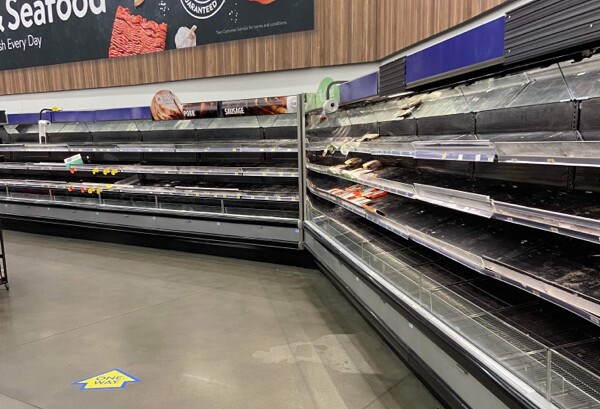While experts say food hoarding is a natural reaction to a shortage threat, one UBC professor says British Columbia has fostered a situation leading to potential food shortages due to flooding.
With unprecedented storms having ravaged parts of the province in recent days, supply lines have been cut, and parts of the province's primary agricultural areas, the Fraser Valley, are underwater. That's vegetables, dairy, beef and chicken supplies under siege.
Panicking people have begun to strip bare the shelves of grocery stores.
While that isn't needed, it is a normal human response to a fear of scarcity, said Brent McFerran, a professor of marketing in Simon Fraser University's Beedie School of Business.
It's a behaviour we see in other kinds of situations such as Black Friday events or electronics stores blowout sales. Still, it's markedly different when it comes to life's essentials, he explained. It's a matter of wants versus needs.
But, if there is a threat of shortage or a perceived threat of shortage, people can engage in panic behaviour, he said. And that can result in herd behaviour. People start to follow the behaviour of others.
"There's a fear underlying it, the fear of the unknown," McFerran said. "That fear we have creates a desire to regain control. Panic buying and hoarding can be a form of control."
It's a situation B.C. saw at the start of the pandemic in spring 2020. People did stockpile but things turned out OK, McFerran said.
Further, McFerran explained, a belief of scarcity—something worsened by poor leadership or media coverage—can mentally tax people. He said people could become shortsighted and selfish. And that can lead to aggression.
"If there is a lack of resources and increasing scarcity, people want to take care of their own," he said.
Shifting messaging
So, how can such behaviour be prevented?
First, McFerran responded, "I don't think excited media reporting of shortages are helping the cause." Moreover, he added that the term 'panic buying' blames the people engaging in it.
He said there needs to be a shift toward messaging that collective action can help, that we should ask how we could help our neighbours and communities.
"We need to reiterate the robustness of the supply chain," McFerran said. Those chains, when stressed, do react, and necessities do return, he added.
And that's been part of the messaging from Victoria.
"People need to do the right thing. Be patient," Minister of Public Safety and Solicitor General Mike Farnworth said Nov. 17. "The goods are going to get where they need to go."
Added Minister of Agriculture Lana Popham, "we won't run out of food."
The professor also cautioned against stores listing items as being rationed. He said it sends a dangerous message to customers that they can't be trusted to be responsible.
For Heidi Ferriman, Save-On-Foods senior vice-president, people and corporate affairs, the crisis is a time where people need to work together.
"We are definitely seeing an increase in volume and order size in our stores, she said. "We saw similar behaviour last March when COVID-19 first hit our communities and our advice to customers is the same now as it was then—please only buy what your family needs.
Ferriman said overbuying puts a strain on stores' ability to get shelves re-stocked as quickly as possible.
"Where appropriate, our teams have instituted limits to prevent panic buying and to ensure our customers have access to the supplies they need," she said. "Our warehouses in Vancouver, Edmonton and Calgary are in great shape, so there is no need for our customers to panic buy."
Ottawa has also stepped up to ensure supply chain integrity to ensure British Columbians get what they need.
Minister of Emergency Preparedness Bill Blair said Nov. 17 that the Canadian Armed Forces would provide logistical planning expertise to support the supply chain analysis, including fuel, communications and other strategic resources.
Food security
For UBC food security specialist Prof. Hannah Wittman, the Fraser Valley becoming a lake comes as no surprise. After all, it was once a lake—Sumac Lake—that was pumped out to create an agricultural zone.
Wittman said there are four pillars to food security: availability, accessibility, the healthiness of food and sustainability of production.
She said the Fraser Valley was already at risk as a food source.
"What these events are showing is making visible the cracks in the food system that have been there for some time," Wittman said.
And, she added, recent events have harmed our ability to be resilient with harm to farms, roads, and distribution systems. The primary issue, she stressed, is not the roads.
"It's not about moving the trucks; it's about repairing the lands," Wittman said. "Do we have time to repair all that before the next growing season?"




